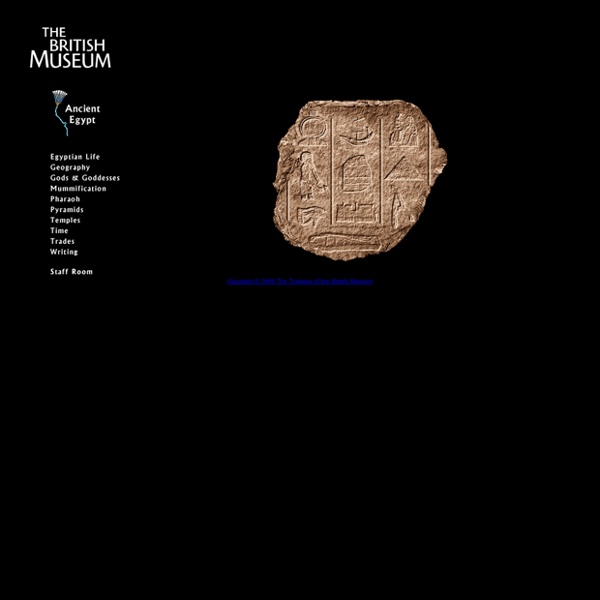



http://www.ancientegypt.co.uk/menu.html
Related: Ancient Egypt Websites • African HistoryCarnegie Museum of Natural History: Life in Ancient Egypt Life in Ancient Egypt Welcome to Life in Ancient Egypt, a companion online exhibition to Walton Hall of Ancient Egypt at Carnegie Museum of Natural History. Carnegie Museum of Natural History has acquired Egyptian artifacts since its founding and now holds about twenty-five-hundred ancient Egyptian artifacts. The most significant of these objects, over six hundred of them, are displayed in Walton Hall of Ancient Egypt. Africa Renewal Online: One plan to replenish Lake Chad Passengers in Nigeria taking ferries to cross Lake Chad, whose shoreline is receding because the lake is drying up. Photograph: Panos / Jacob Silberberg As you approach the Lake Chad basin from Maiduguri, in northeastern Nigeria, the atmosphere of despair is telling.
Cracking the Hieroglyphic Code" The earliest attempt at translating hieroglyphics came well before the discovery of the Rosetta Stone. A fifth-century scholar named Horapollo set up a translation system based on hieroglyphics' relation to Egyptian allegories. After Horapollo's hypothesis, 15 centuries of scholars dedicated themselves to a false translation system. NatGeo: King Tut Revealed By A.R. Williams He was just a teenager when he died. The last heir of a powerful family that had ruled Egypt and its empire for centuries, he was laid to rest laden with gold and eventually forgotten. Since the discovery of his tomb in 1922, the modern world has speculated about what happened to him, with murder the most extreme possibility.
Ancient Egypt - Ancient History Under Ahmose I, the first king of the 18th dynasty, Egypt was once again reunited. During the 18th dynasty, Egypt restored its control over Nubia and began military campaigns in Palestine, clashing with other powers in the area such as the Mitannians and the Hittites. The country went on to establish the world’s first great empire, stretching from Nubia to the Euphrates River in Asia.
Lake Chad: almost gone - Vital Water Graphics: Solid maps to accompany article Straddling the borders of Chad, Niger and Cameroon in West Africa, Lake Chad has been a source of freshwater for irrigation projects in each of these countries. Maps drawn from a series of satellite images show a dramatic decrease in the size of the lake over the past 30 years. Since 1963, the lake has shrunk to nearly a twentieth of its original size, due both to climatic changes and to high demands for agricultural water. Since 1963, the surface area of Lake Chad has decreased from approximately 25,000 km2 to 1,350 km2 (Scientific American, 2001).
Pyramid Discoveries Will Force History to be Re-Written The world’s largest and oldest pyramid has been discovered in Bosnia A pyramid has been discovered in Bosnia-Herzegovina that is larger, older and more perfectly oriented than Egypt’s Great Pyramid of Giza. Located near the city of Visoko, not only is it the first pyramid to be discovered in Europe, but it is also the largest valley of pyramids in the world.
Explore Ancient Egypt Explore Ancient Egypt With 360-degree and other imagery, walk around the Sphinx, enter the Great Pyramid, visit tombs and temples, and more. Want to walk around the Sphinx? Clamber inside the Great Pyramid of Giza and seek out the pharaoh's burial chamber? Visit the magnificent tombs and temples of ancient Thebes? In this multi-layered, highly visual interactive, view 360° panoramas, "walkaround" photos, and other breathtaking imagery shot throughout the Giza Plateau and ancient Thebes (modern-day Luxor), often with special permission. New clues illuminate mysteries of ancient Egyptian portraits WASHINGTON — Scientists are getting a clearer picture of how ancient Egyptians painted lifelike portraits that were buried with mummies of the depicted individuals. These paintings sharply departed from Egyptians’ previous, simpler artworks and were among the first examples of modern Western portraits, archaeologist and materials scientist Marc Walton reported February 14 at the annual meeting of the American Association for the Advancement of Science. The “mummy portraits” date to more than 2,000 years ago, when the Roman Empire controlled Egypt. Three such portraits of Roman-era Egyptians, found more than a century ago at site called Tebtunis, were created by the same artist, said Walton, of Northwestern University in Evanston, Ill. Identities of the boy and two men in the portraits are unknown. Many pigments in the portraits probably came from Greece, Walton said.
Sucking Dry an African Giant Lake Chad has literally gone from being an oasis in the desert, to being just desert. Spanning the countries of Chad, Nigeria, Niger and Cameroon and bordering the Sahara desert, Lake Chad has contracted by a massive 95% between 1963 and 2001. Some stunning satellite images from NASA and compelling time-series video from Circle of Blue demonstrate the rapid decline of what was formerly the world’s 6th largest lake. According to the United Nations Environment Programme (UNEP), about half of the shrinkage of the traditionally shallow Lake Chad has been caused by climatic changes, and the other half by high demand for agricultural water.
Real life experiments that reveal the ancient art and techniques of building Egyptian pyramids Copyright © 2006 by Mike Molyneaux New insights into ancient pyramid construction techniques presented in this article include the following:- [1] The use of battering rams to create acoustic energy for quarrying, shifting and positioning stones. [2] The use of counter-ramps with counter-weight principles for hauling massive stones uphill. [3] The use of overlapping planks and rollers to create an auto-aligning, auto-braking system for the ramps. [4] The use of leveraging towers with counter-weights for lifting stones out of a quarry and onto rollers. [5] Submerging large stones in watery mud for transporting them down rivers or along canals. [6] Partially completed courses of the pyramid forming a spiral staircase to support a ramp to the inner chambers. 1 Actual experiments using scale models A new, realistic set of trials and experiments using scale models or children have now revealed how easily large stones can be transported with rather primitive technology.